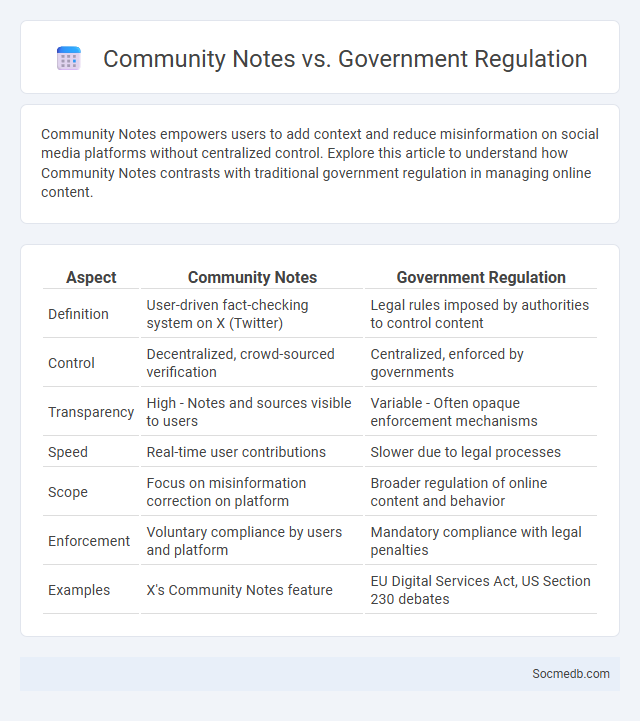
Photo illustration: Community Notes vs Government Regulation
Community Notes empowers users to add context and reduce misinformation on social media platforms without centralized control. Explore this article to understand how Community Notes contrasts with traditional government regulation in managing online content.
Table of Comparison
| Aspect | Community Notes | Government Regulation |
|---|---|---|
| Definition | User-driven fact-checking system on X (Twitter) | Legal rules imposed by authorities to control content |
| Control | Decentralized, crowd-sourced verification | Centralized, enforced by governments |
| Transparency | High - Notes and sources visible to users | Variable - Often opaque enforcement mechanisms |
| Speed | Real-time user contributions | Slower due to legal processes |
| Scope | Focus on misinformation correction on platform | Broader regulation of online content and behavior |
| Enforcement | Voluntary compliance by users and platform | Mandatory compliance with legal penalties |
| Examples | X's Community Notes feature | EU Digital Services Act, US Section 230 debates |
Introduction to Community Notes and Government Regulation
Community Notes provide a platform for users to collaboratively add context and verify information on social media posts, enhancing transparency and trust. Government regulation increasingly targets social media to curb misinformation, enforce data privacy, and ensure platform accountability. These measures aim to balance user freedom with public safety and information integrity.
Defining Community Notes: Origins and Purpose
Community Notes originated as a collaborative fact-checking tool designed to enhance transparency and reduce misinformation on social media platforms. This initiative empowers users to add context to potentially misleading posts, fostering a more informed online community. By leveraging collective knowledge, Community Notes aims to improve content accuracy while promoting engagement and trust among social media users.
Government Regulation Explained: Scope and Intent
Government regulation of social media aims to address issues such as misinformation, user privacy, and content moderation by establishing clear legal frameworks and compliance standards. These regulations often define the responsibilities of platforms in monitoring harmful content while protecting freedom of expression and ensuring data security. Understanding these rules helps you navigate the digital landscape responsibly and stay informed about your rights and obligations online.
Key Differences Between Community Notes and Government Oversight
Community Notes is a crowdsourced fact-checking tool that empowers users to add context and identify misinformation on social media platforms, enhancing transparency and user participation. Government Oversight involves regulatory bodies enforcing laws and policies to monitor and control social media content, prioritizing legal compliance and public safety. While Community Notes relies on collective user input for accountability, Government Oversight exercises formal authority to impose restrictions and penalties.
Strengths of Community-Driven Fact-Checking
Community-driven fact-checking leverages collective intelligence to rapidly identify and correct misinformation, enhancing the accuracy of shared information. Your participation in these social media efforts strengthens transparency and trust by promoting diverse perspectives and real-time verification. This collaborative approach also fosters digital literacy, empowering users to discern credible sources and reduce the spread of false content.
Limitations and Challenges of Government Regulation
Government regulation of social media faces significant limitations due to the rapid evolution of platforms and the global nature of content sharing, which complicates enforcement across jurisdictions. Your ability to navigate these challenges is affected by issues such as balancing free speech with harmful content control, technological circumvention by users, and the risk of overreach infringing on privacy and innovation. Regulatory frameworks must continuously adapt to address misinformation, data privacy concerns, and the influence of powerful tech companies without stifling digital expression.
Case Studies: Community Notes in Action
Community Notes enhances social media transparency by allowing users to collaboratively add context to misleading posts, improving information accuracy. Case studies reveal significant reductions in misinformation spread on platforms like Twitter, where user-generated notes have debunked viral false claims. Your engagement with Community Notes supports a more informed online community, promoting trust and accountability across social networks.
Comparing Effectiveness: Community Notes vs Government Regulation
Community Notes leverage user-generated content to enhance fact-checking on social media platforms, offering timely and diverse perspectives that adapt quickly to emerging misinformation. Government regulation imposes formal oversight with legal authority, potentially ensuring consistent enforcement but often facing challenges in scalability and responsiveness. Your engagement with Community Notes can provide a more dynamic and participatory approach to combating false information compared to traditional regulatory measures.
Potential Synergies and Conflicts
Social media platforms offer potential synergies by enabling seamless integration of marketing, customer service, and community engagement, enhancing Your brand's reach and customer loyalty. However, conflicts arise due to differing platform algorithms, inconsistent messaging, and privacy concerns, which can undermine brand trust and cause audience fragmentation. Balancing these synergies and conflicts is essential for maximizing social media impact while minimizing risks.
The Future of Misinformation Management: Collaborative Approaches
Social media platforms are increasingly adopting collaborative approaches to combat misinformation by leveraging cross-industry partnerships, artificial intelligence, and community-driven fact-checking initiatives. These strategies emphasize real-time detection and rapid response, combining the expertise of technology companies, governments, and independent organizations to enhance content verification accuracy. Enhanced transparency and user education campaigns also play a crucial role in fostering digital literacy and empowering users to identify and report false information effectively.
 socmedb.com
socmedb.com